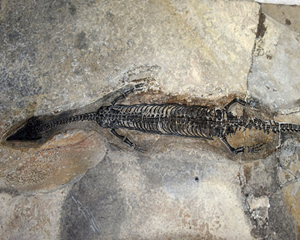Chinese paleontologists have discovered the fossil of a new marine reptile species, dating back 244 million years, in Luoping County, Southwest China's Yunnan province.
中国古生物学家在中国西南的云南省罗平县发现了一种据今2.44亿年、新的海洋爬行动物的化石。
The study was published in the journal Scientific Reports on Thursday.
这项研究于周四发表在《科学报告》期刊上。
The species, Luopingosaurus, is a lizard-like marine reptile.
该物种被命名为“奇异罗平龙”,是一种类似蜥蜴的海洋爬行动物。
It is known as a pachypleurosaur with a long, pointed mouth, reaching more than half a meter in length.
它被称为肿肋龙,嘴长而尖,身长超过半米。
The long snout, accounting for over half of its head, facilitated the reptile to catch prey as it could largely reduce resistance during chases in the water,
奇异罗平龙的吻端很长,超过头长的一半,这有助于它们捕捉猎物,因为在水中追逐时,这一特征在很大程度上能减少阻力。
said Shang Qinghua, a researcher from the Institute of Vertebrate Paleontology and Paleoanthropology under the Chinese Academy of Sciences.
中国科学院古脊椎动物与古人类研究所研究员尚庆华如是说。
The discovery provided new insights into the early evolution of pachypleurosaur, Shang added.
尚庆华还补充称,这一发现为了解肿肋龙类的早期演化提供了新的见解。

According to the study, the reptile's forelegs had multiple phalanges, making its flippers more flexible when changing direction in the water.
根据这项研究,这种爬行动物的前肢有多根趾骨,这使得它的鳍状肢在水中改变方向时能更加灵活。
The discovery also represented the oldest fossil evidence of Sauropterygia with multiple phalanges.
这一发现也代表了多指节型鳍龙类迄今已知最古老的化石证据。
The study also indicated that during the evolutionary process, the lateral grasping ability of pachypleurosaurs for small fish and other prey is gradually increasing,
该研究还表明,在演化过程中,肿肋龙对小鱼等猎物的侧向抓取能力逐渐增强,
but the efficiency of swallowing after grasping is gradually decreasing.
但抓捕后的吞咽效率却逐渐降低。
During the Triassic period, Luoping was in a shallow marine environment, and the middle Triassic fossil bank found in the area is called the Luoping Biota.
在三叠纪时期,罗平处于浅海环境中,在该地区发现的中三叠纪化石库被称为罗平生物群。
The first named marine reptile discovered in China was also a pachypleurosaur, the Keichousaurus, found in 1957.
在中国发现的第一个命名的海洋爬行动物,也是一种肿肋龙,即1957年发现的贵州龙。













